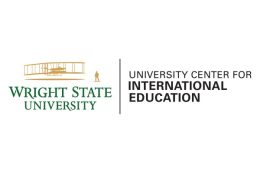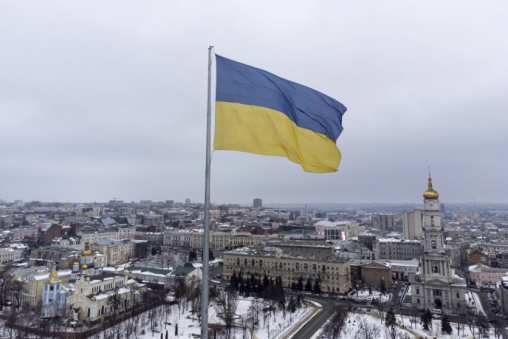Twelve Wright State University students are getting exposed to war through a special five-week series of video exchanges with the same number of their counterparts in Kharkiv, Ukraine, on the frontlines of the Russian-Ukrainian war.
“War and Society in Ukraine: Collaborative Online International Learning” will run weekly from March 21 through April 17.
“That faculty and students from a university that has been destroyed by Russian missiles and who remain under siege are willing and able to participate in the program is, to me, truly remarkable,” said Sean Pollock, Ph.D., associate professor of history at Wright State and the series’ lead organizer.
The Ukrainian students have been displaced from their school, the V.N. Karazin Kharkiv National University.
“They are dispersed throughout the country or studying underground,” said Pollock, who is also the director of the graduate program in history in the School of Humanities and Cultural Studies in the College of Liberal Arts.
The Wright State and Ukrainian students will see and hear each other through Wright State’s Collaborative Online International Learning (COIL) program.
“During this time of war, friction and uncertainty,” said Michelle Streeter-Ferrari, director of the University Center for International Education, “having so many Wright State students use technology to connect and collaborate with other students in Ukraine exposes them to an exchange they would not otherwise be able to experience.”
Pollock said the initial video get-together was introductory for both sides. The following four sessions will have a speaker and theme. Pollock will lecture in the first session about Russian President Vladimir Putin’s reasons for the war. Each of the remaining lectures will be by Ukrainian scholars about the plight of refugees, the role of universities in rebuilding Ukraine and information technology in the war.
Each lecture will be 40 minutes with 20 minutes for questions. “The lecturers and students are proficient in English,” Pollock said.
“The idea is, to the extent that we can, avoid political questions and focus on this effort to build a bridge between civil societies in America and Ukraine,” Pollock said.
This project grew from Pollock’s service on the board of directors of the Cincinnati-Kharkiv Sister City Partnership. Pollock, who is a Cincinnati resident, said the partnership has a contact with the Ukrainian national university’s faculty, Viktoria Mariniuk.
“This is a pilot project, and we wanted to keep it small,” Pollock said. “It developed late in the semester. It’s kind of a miracle that it’s launching at all.”
 Pollock said the Ukrainian students are aware of what’s coming out of Russia about the war, but they don’t know what Americans think about the conflict.
Pollock said the Ukrainian students are aware of what’s coming out of Russia about the war, but they don’t know what Americans think about the conflict.
“This is a perspective they might find valuable,” he said.
“One more thing the Ukrainians may get out of this: normalcy,” he added. “This represents a safe space to learn and to continue to just be students. There’s an escapist quality. Wherever they are, this’ll be an hour to attend to their intellectual growth.”
“For Wright State students this is an opportunity for them to engage with Ukrainian students in a deep and profound way,” Streeter-Ferrari said.
Streeter-Ferrari said the University Center for International Education hopes that the COIL program can provide an international experience for more Wright State students, especially in Africa, Latin America and Asia, places where they do not usually travel.
“Most American students tend to study abroad in Europe,” she said.
Nationally about 11% of those in higher education take part in study abroad or participate in international travel for academic purposes.
“The idea behind COIL has begun growing in the field of international education,” Streeter-Ferrari said.
It provides students who may not have the resources or ability to easily travel, such as students with disabilities, the means to learn about other parts of the world.
She said employment opportunities more often are likely to cross borders and students entering the job market need to have these experiences.
“When I did study abroad in the 1990s,” Pollock said, “there was no internet or smartphones. The world was not globally connected as it is today.”
He said that by 2025 96% of the world will be connected virtually.
“That’s the world we want our students to succeed in,” he said.


 Gov. DeWine reappoints Board Treasurer Beth Ferris and names student Ella Vaught to Wright State Board of Trustees
Gov. DeWine reappoints Board Treasurer Beth Ferris and names student Ella Vaught to Wright State Board of Trustees  Joe Gruenberg’s 40-Year support for Wright State celebrated with Honorary Alumnus Award
Joe Gruenberg’s 40-Year support for Wright State celebrated with Honorary Alumnus Award  Wright State’s elementary education program earns A+ rating for math teacher training
Wright State’s elementary education program earns A+ rating for math teacher training  Wright State’s Calamityville hosts its largest joint medical training operation
Wright State’s Calamityville hosts its largest joint medical training operation  Wright State University launches Strategic Plan 2030 to advance student success, enhance role as regional economic driver
Wright State University launches Strategic Plan 2030 to advance student success, enhance role as regional economic driver 